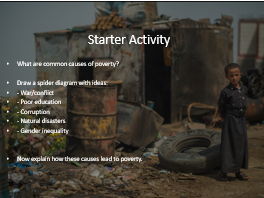


This engaging and fully resourced lesson explores the core question: Why is Yemen the poorest country in the Middle East? Students investigate the complex causes of poverty in Yemen—including conflict, corruption, lack of infrastructure, and gender inequality—through guided group research using laptops or tablets. A development indicators comparison with Saudi Arabia (e.g. GDP per capita, literacy, access to water) deepens understanding of what drives wealth and poverty across nations. Visual aids such as maps, and poverty-related images are included, with placeholders allowing you to easily adapt or update them. Activities include a starter spider diagram, a development data table, and a letter-writing task to Yemen’s president proposing solutions. Perfect for KS3 or KS4 Geography or Citizenship lessons with strong cross-curricular links to global development and economics.
Get this resource as part of a bundle and save up to 47%
A bundle is a package of resources grouped together to teach a particular topic, or a series of lessons, in one place.
The Middle-East unit plus booklet
Take your KS3 students on a journey through one of the most fascinating and misunderstood regions of the world with this engaging and fully resourced Middle East unit. This scheme of work introduces students to the physical geography, human landscapes, and contemporary challenges of the Middle East, including climate, conflict, resource management, and population dynamics. With case studies, enquiry-based tasks, and interactive activities—including map skills, data interpretation, and decision-making exercises—students develop a well-rounded and critical understanding of this diverse region. Perfect for deepening global awareness and building synoptic links across the geography curriculum.
The Middle-East KS3
Take your KS3 students on a journey through one of the most fascinating and misunderstood regions of the world with this engaging and fully resourced Middle East unit. This scheme of work introduces students to the physical geography, human landscapes, and contemporary challenges of the Middle East, including climate, conflict, resource management, and population dynamics. With case studies, enquiry-based tasks, and interactive activities—including map skills, data interpretation, and decision-making exercises—students develop a well-rounded and critical understanding of this diverse region. Perfect for deepening global awareness and building synoptic links across the geography curriculum.
Something went wrong, please try again later.
This resource hasn't been reviewed yet
To ensure quality for our reviews, only customers who have purchased this resource can review it
to let us know if it violates our terms and conditions.
Our customer service team will review your report and will be in touch.